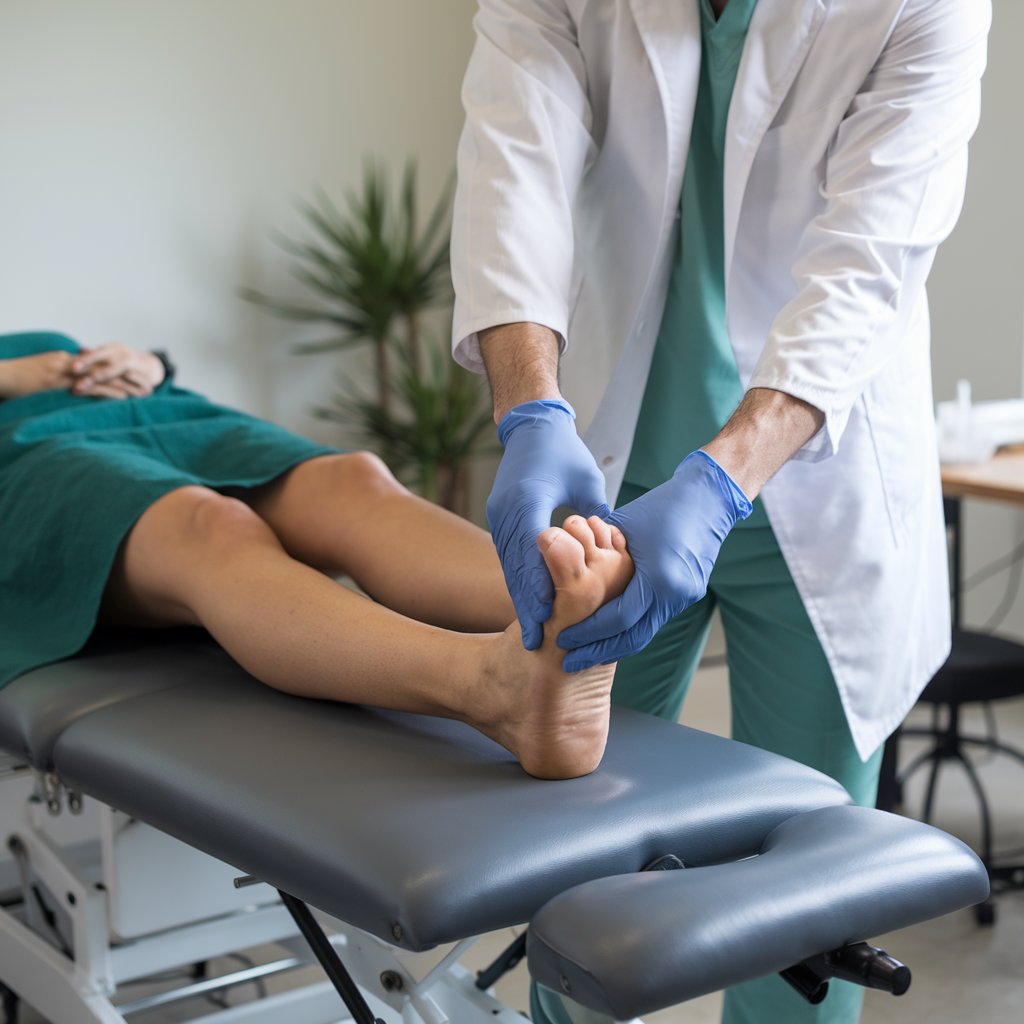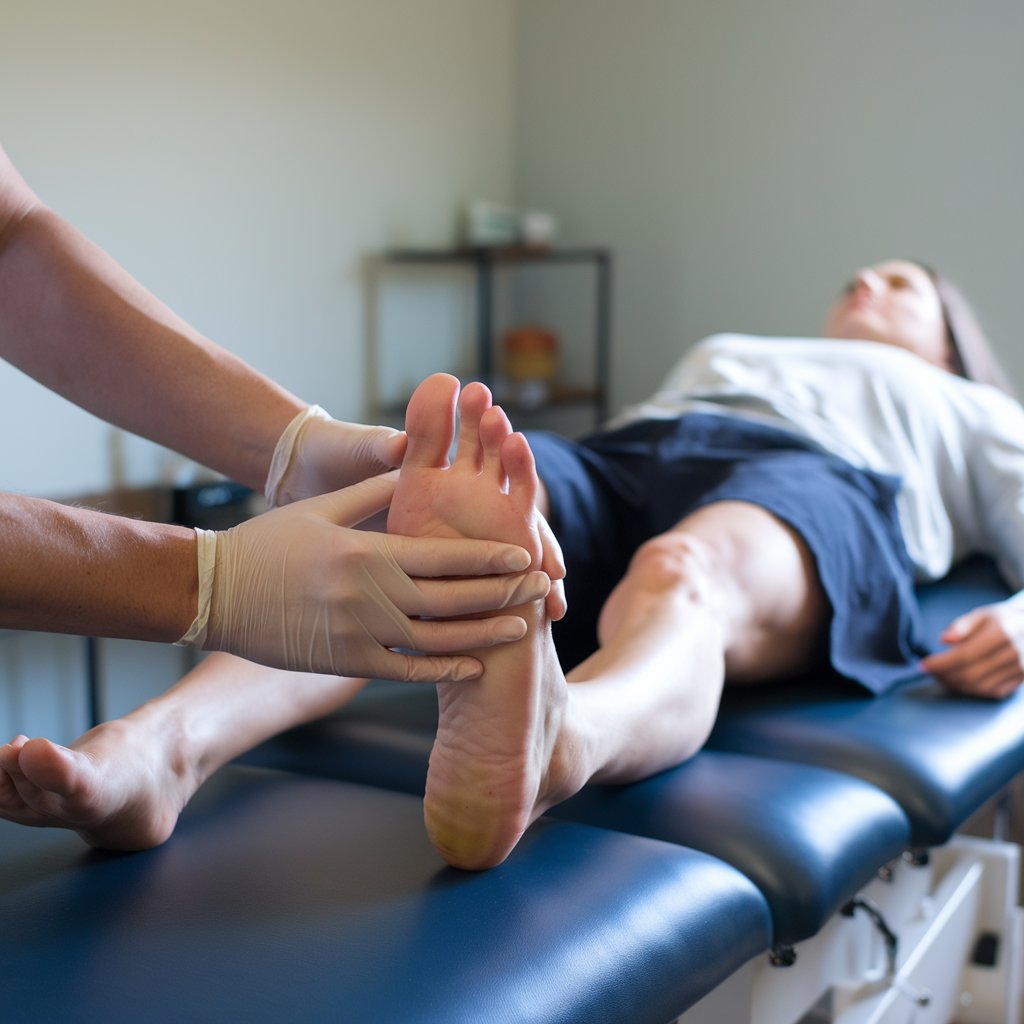Effective Chiropractor for Plantar Fasciitis Relief

Imagine waking up one sunny morning, ready for a hike with friends, but feeling a sharp pain in your heel. This is what millions of Americans face with plantar fasciitis. It stops many from doing what they love. Did you know 1 in 10 people will get this pain at some point?
For those between 40 to 60, especially women, it’s even more common. But, many find relief with chiropractic care. Searching for the best chiropractor has led many to find treatments like muscle stretching and adjustments. These help not just with pain, but also improve how well you can move. Let’s see how chiropractic care for plantar fasciitis can make a big difference.
Table of Contents
Understanding Plantar Fasciitis
Plantar fasciitis is when the plantar fascia, a tissue band, gets inflamed. This band links the heel bone to the toes. The pain is usually felt in the heel, especially in the morning or after sitting or standing a lot. It’s the top reason for heel pain in the U.S., hitting middle-aged folks the hardest.
Anyone can get it, but 75% of Americans will face foot pain at some point. Runners, those with foot arch problems, and people on their feet a lot are more likely to get it. Being overweight and wearing the wrong shoes also increases the risk. The pain can make everyday tasks hard.
Chiropractic care is a natural way to deal with plantar fasciitis. Chiropractors use adjustments to ease stress in the plantar fascia, helping it heal. This method can speed up recovery, alongside physical therapy or massage. Regular chiropractic visits can also help prevent future plantar fasciitis.
| Aspect | Details |
|---|---|
| Common Age Group | 40-60 years |
| Typical Symptoms | Heel pain, stiffness, tenderness |
| Contributing Factors | Obesity, inappropriate footwear, limited ankle flexibility |
| Recovery Time | Several months |
| Chiropractic Benefits | Reduces stress, promotes healing, prevents further injury |
Symptoms of Plantar Fasciitis
Plantar fasciitis brings sharp heel pain, especially when you first step out of bed or after sitting for a long time. This pain often fades as you move around, but can come back after standing or walking for a while. Spotting these signs early can help stop it from becoming a long-term problem.
Common signs of heel pain include:
- Sharp or stabbing pain in the heel or arch of the foot
- Stiffness in the foot, particularly upon waking
- Aching or burning sensations in the foot, often radiating up the leg
- Tightness when standing after periods of inactivity
It’s important to know these symptoms, especially if you’re always on your feet. This includes athletes or people with jobs that require a lot of physical activity. Seeing a doctor early can make a big difference in how well you can move again.
Chiropractor for Plantar Fasciitis: How Can They Help?

A chiropractor for plantar fasciitis offers vital help for those in pain. *Chiropractic care benefits* by tackling the underlying causes, not just the symptoms. Chiropractors use various methods to help with plantar fasciitis treatment.
Chiropractors look at the whole body to find the source of pain. They know that plantar fasciitis can come from things like too much exercise, bad shoes, or old injuries. This full-body view is key to treating the issue well.
Common signs of plantar fasciitis include:
- Dull throbbing pain at rest
- Sharp stabbing pain during activities
- Aching sensations in the heel
- Stiffness in the foot
- Loss of motion
Plantar fasciitis happens when the plantar fascia gets too stretched out. Chiropractors use different treatments to ease this stress and help heal. These treatments might be:
- Chiropractic adjustments
- Active Release Techniques (ART)
- Dry needling
- Functional rehabilitation therapy
- Taping and support
Adding home care to professional treatment can speed up recovery. This includes icing, wearing the right shoes, and doing foot stretches. By changing your lifestyle and using *chiropractic care benefits*, you can fully recover.
Chiropractors focus on safe ways to heal and improve movement. This makes dealing with plantar fasciitis easier. For more info on medical topics, check out this resource.
Benefits of Chiropractic Care for Plantar Fasciitis
Chiropractic care for plantar fasciitis offers many benefits for foot health and quality of life. Every year, about 2 million people seek help for this issue. The goal is to lessen pain and boost functionality.
Seeing a foot pain relief chiropractor helps tackle the root causes of plantar fasciitis, not just the symptoms. Chiropractors use specific adjustments, like heel and spine realignments, to fix body mechanics. This method helps reduce inflammation in the plantar fascia, leading to relief and better foot function.
- Effective pain management through targeted adjustments.
- Enhanced mobility by improving the alignment of the spine and joints.
- Overall health improvements from correcting misalignments that stress the plantar fascia.
- Involvement of specialized techniques, such as Active Release Techniques, to relieve muscle tension in the feet and lower back.
Chiropractic care also includes personalized advice for lifestyle changes and prevention. This approach ensures patients don’t lose time and learn how to keep their feet healthy. It helps with weight management too.
This mix of treatments and advice greatly lowers the risk of chronic conditions from plantar fasciitis. People can quickly get back to their activities, feeling better overall.
Chiropractic Treatment Techniques for Plantar Fasciitis

Plantar fasciitis is a common issue in the U.S., causing a lot of pain and potential long-term problems. Chiropractors use several techniques to help with symptoms and aid healing. These include chiropractic techniques for plantar fasciitis like manual therapies, soft tissue manipulation, and adjustments to the heel and ankle.
Studies show that different methods can help. For example, fascia taping can lessen strain on the fascia band, especially for athletes. Stretching exercises are also key in effective chiropractic treatment. They improve mobility and lessen pain for many people.
Chiropractic adjustments focus on fixing misalignments and easing stress on the plantar fascia. If you have hyperpronation or fallen arches, these adjustments can help. They often come with custom foot orthotics for better arch support.
Chiropractors use various treatments along with adjustments. These include:
- Massage therapy to reduce muscle tension.
- Ice therapy for pain relief and inflammation control.
- Strengthening exercises targeting the calf muscles and plantar fascia.
- Night splints to keep the foot in the right position and aid healing while resting.
Chiropractic care for plantar fasciitis aims to create a detailed plan for recovery and better function. Since half of those affected have symptoms for over a decade, getting chiropractic adjustments for plantar fasciitis is key to getting back on your feet and reducing pain.
| Chiropractic Techniques | Benefits |
|---|---|
| Manual Therapy | Alleviates pressure and encourages healing |
| Soft Tissue Manipulation | Reduces muscle tension and improves circulation |
| Fascia Taping | Supports the foot structure during activities |
| Strengthening Exercises | Enhances muscle support and stability |
| Night Splints | Keeps the foot in a healing position overnight |
Manual Therapy in Chiropractic Care
Manual therapy uses various techniques to help with pain and restore movement in conditions like plantar fasciitis. It includes joint mobilization of the ankle and massages for the calf and plantar fascia. These methods are key to easing tension in the plantar fascia and helping with recovery.
Research shows that combining cross friction massage and stretching the gastrocsoleus complex helps a lot. It reduces pain, improves movement, and lessens disability in plantar fasciitis patients. When chiropractic manual therapy uses these methods, along with traditional foot adjustments, patients get better results.
About 90% of people with plantar fasciitis get better with conservative treatments like manual therapy for plantar fasciitis. Joint mobilizations and specific stretches increase movement and lessen pain. Chiropractors customize their care for each patient, leading to the best outcomes.
This approach doesn’t just focus on the affected area. It also helps with overall body function, improving mobility and reducing pain from other musculoskeletal issues. By focusing on foot adjustments and detailed treatment plans, chiropractic care offers a non-invasive way to manage plantar fasciitis.
Stretching and Exercise: Key Components
Managing plantar fasciitis well means stretching and exercising regularly. These steps help with pain relief and are key to getting better. By focusing on the calf muscles, Achilles tendon, and plantar fascia, people can see big health gains.
Benefits of stretching for plantar fasciitis include:
- Enhanced flexibility in the calf muscles.
- Reduced tension in the Achilles tendon.
- Increased blood flow to the plantar fascia.
It’s also vital to do exercises for heel pain. Some good exercises to try are:
- Calf Stretches: Hold each stretch for at least 30 seconds to make your calf muscles more flexible.
- Calf Raises: Doing these exercises strengthens your lower limb muscles and helps with stability.
- Toe Curls: This exercise works on the muscles in your foot, which is key for absorbing shock.
Studies show that low-impact activities like swimming and cycling are good for your heart and don’t make heel pain worse. Adding stretching and exercise regularly can lower the chance of it coming back and boost your foot health. Using both rehab and prevention steps is a full way to handle plantar fasciitis.
Myofascial Release Techniques
Myofascial release is a great way to help with foot pain from plantar fasciitis. It focuses on the fascia, a tissue that needs special attention to ease tension and swelling. Chiropractors use methods like transverse friction massage and tool-assisted soft tissue work for the best results.
Plantar fasciitis often causes sharp pain in the arch or heel, especially when you first get up. Using myofascial release can lessen swelling and boost healing. It also helps improve blood flow in the affected area. Chiropractors focus on spine and foot alignment to support healing and prevent future problems.
Combining myofascial release with other chiropractic methods gives full care for plantar fasciitis. Chiropractors can spot misalignments in the spine and foot that cause pain. With custom orthotics and this treatment, pressure on the plantar fascia goes down, reducing the chance of more pain.
The table below shows the main myofascial release techniques and their benefits for plantar fasciitis:
| Technique | Description | Benefits |
|---|---|---|
| Transverse Friction Massage | Targets connective tissue to improve flexibility. | Reduces stiffness and increases range of motion. |
| Instrument-Assisted Soft Tissue Manipulation | Uses tools to ease muscle tension. | Speeds up healing and cuts down muscle adhesions. |
| Deep Tissue Massage | Works on deeper muscle and fascia layers. | Helps with chronic pain and relaxation. |
| Trigger Point Therapy | Finds and releases tight muscle spots. | Targets pain areas, improving mobility. |
People getting myofascial release often find it helps their chiropractic care. It leads to better relief from plantar fasciitis symptoms. A personalized plan that includes soft tissue work, stretching, and advice on lifestyle is key to healing. For more on how psychotherapy helps with other health issues, check out this link.
Importance of Orthotics in Treatment
Orthotics for plantar fasciitis are key for people with this common issue. They help keep the arch in the right shape. This reduces stress on the plantar fascia and improves how the foot works. With two million people in the U.S. affected, using the right foot support is crucial for easing pain and helping with treatment.
Custom orthotics are a top choice over off-the-shelf ones. They provide specific relief and support for each person’s needs. Studies show that custom foot orthoses improve both function and pain levels more than standard treatments. This proves the importance of adding orthotics to a full treatment plan.
Supportive shoes also play a big part in treating plantar fasciitis. It’s best to wear low-heeled shoes with good arch support and enough room for orthotics. High-heeled or poorly supported shoes can make things worse. Following these tips can greatly improve treatment success and make everyday life more comfortable.
Chiropractic Adjustments for Enhanced Mobility
Chiropractic adjustments for foot problems are key to better foot function and mobility. They realign bones and joints, improving how we walk and easing plantar fascia tension. This helps those with plantar fasciitis heal faster.
Chiropractic care uses many mobility enhancement techniques. It includes spinal and foot adjustments that help the whole body work better. Many people feel less pain after these treatments, which improves their life quality.
Chiropractors often suggest custom orthotics as part of treatment. These orthotics give specific support to each patient. Exercises and stretches also strengthen the plantar fascia and soft tissues, boosting mobility.
Every year, over 2 million people in the U.S. get treatment for plantar fasciitis. This shows how common the condition is, especially in people aged 40 to 60. Those who work long hours on their feet are more likely to get it.
| Chiropractic Treatment Benefits | Details |
|---|---|
| Pain Relief | Many patients report significant pain relief following chiropractic adjustments for plantar fasciitis. |
| Non-Surgical Approach | Chiropractic care offers a non-invasive alternative to surgery, making it a safer option for many. |
| Improved Mobility | Techniques focusing on enhancing ankle and foot mobility aid in restoring full function. |
| Customized Treatment | Chiropractic care involves personalized orthotics and tailored exercises to meet individual needs. |
| Reduced Risk of Complications | Effective treatment of foot pain prevents compensatory gait changes that could lead to more serious issues. |
Chiropractic adjustments help with foot pain and improve mobility over time. They let patients feel better and live more actively. These adjustments are key to a full recovery plan. For more on improving endurance and fitness, check out effective exercises to increase your sexual stamina.
How Chiropractic Care Provides Pain Relief
Chiropractic care uses various techniques to help with pain from plantar fasciitis. It’s a non-invasive method that focuses on fixing spinal alignment and improving nerve function. A pain relief chiropractor targets the main cause of heel pain, not just the symptoms.
Common techniques for foot pain include:
- Manual adjustments to correct mis-alignments.
- Therapeutic ultrasound to reduce inflammation.
- Dry needling for muscle tension relief.
Spinal adjustments help improve nerve function, sending important signals to the feet. Adjustments in the lower back also help by easing stress on the plantar fascia and ligaments. Chiropractors recommend stretching regularly to help with recovery and prevent future pain.
In severe cases, chiropractors might adjust ankles and feet to tackle underlying issues. Their goal is to help heal and reduce the chance of future pain. Chiropractic care is a key part of a full plan to manage foot pain well.
Role of Night Splints in Recovery
Night splints are key for people with plantar fasciitis. They keep the foot bent while you sleep, stopping the plantar fascia from shortening. This helps reduce pain in the morning.
While night splints ease pain, they don’t fully prevent plantar fasciitis from coming back. It’s important to fix the root causes like tight calves and poor ankle movement. Active Isolated Stretching can be better for healing than night splints.
For the best recovery, use night splints with other methods. This means better shoes, stronger feet, and proper foot function. Experts like Dr. Angela Walk suggest a full treatment plan. Night splints are helpful, but they’re part of a bigger plan for lasting relief.
| Aspect | Night Splints | Active Isolated Stretching |
|---|---|---|
| Purpose | Maintain foot position to prevent shortening of plantar fascia | Increase flexibility and strength of foot muscles |
| Short-term Pain Relief | Effective in reducing morning pain | Potentially more effective through active engagement |
| Long-term Results | Limited impact on preventing recurrence | Supports rehabilitation and functional improvement |
| Complementary Use | Best used with proper footwear and strength exercises | Recommended to be included in a comprehensive rehab program |
Extracorporeal Shockwave Therapy and Its Effectiveness

Extracorporeal shockwave therapy (ESWT) is a new way to treat plantar fasciitis. It uses sound waves to help heal the plantar fascia. This method is non-invasive and helps many people who suffer from this common foot problem.
About 10% of people get plantar fasciitis, making new treatments like ESWW important. It’s a way to ease pain without surgery.
- Shockwave therapy can help 44% to 80% of people with plantar fasciitis feel better.
- Combining shockwave therapy with physical therapy can lead to better recovery over time.
- A 2021 study showed that four sessions of this therapy reduced inflammation and made the plantar fascia thinner.
Every year, over 1 million people in the U.S. seek help for plantar fasciitis. Traditional treatments work for most, but 10% need more help. ESWT is an option for those who don’t get better with usual treatments.
The FDA approved ESWT for plantar fasciitis in 2000. It was a big step forward in treating foot pain. But, we need more research to know if it works long-term.
Shockwave therapy costs about $1,000 without insurance. Prices vary by location and who does the treatment. Since many insurance plans don’t cover it, people must think about cost and how well it works.
Good sleep is key to being healthy and productive. You can find tips to improve sleep on this page.
| Study Year | Findings | Participants |
|---|---|---|
| 2021 | Reduced plantar fascia thickness and decreased inflammation symptoms | Small cohort |
| 2020 | Rapid decrease in pain following treatment | Small cohort |
| 2018 | Combined treatment with physical therapy showed more effective long-term healing | Case-series |
Prevention Strategies for Plantar Fasciitis
Preventing plantar fasciitis means taking care of your foot health. By using the right strategies, you can lower your risk of getting this painful condition.
- Wear Supportive Footwear: Pick shoes that give your arch good support and cushioning. Stay away from flat shoes that don’t support your feet, as they can make heel pain worse.
- Maintain a Healthy Weight: Being overweight is a risk factor for plantar fasciitis. Keep your weight in check with healthy eating and regular exercise to lessen stress on your plantar fascia.
- Engage in Regular Stretching: Do stretching exercises for your feet, calves, and Achilles tendon. This will make your feet more flexible and reduce tension in the plantar fascia.
- Avoid Hard Surfaces: When you’re working out, choose softer surfaces that absorb shock better. Hard surfaces can make foot pain worse and lead to overuse injuries.
- Gradually Increase Activity Levels: If you’re starting a new exercise routine, increase your intensity and time slowly. This helps prevent straining your feet.
- Recognize Early Signs of Pain: Notice any foot discomfort early. Taking action early can stop more serious symptoms from happening.
Using these foot care tips every day can help prevent plantar fasciitis. It lets you stay active and lowers the risk of heel pain.
Finding the Best Chiropractor for Plantar Fasciitis
Looking for the best chiropractor for plantar fasciitis means checking a few key things. First, make sure the chiropractor has the right training and skills for foot issues. They should have experience with plantar fasciitis and similar problems.
Reading what other patients say can give you a good idea of the care quality at a chiropractic clinic near you. Happy patients often talk about getting good treatment and feeling listened to. It’s a good idea to call clinics to learn more about how they help with foot pain.
When finding foot care specialists, look for those who use a whole-body approach. A good chiropractor will check your symptoms, do a physical exam, and might use imaging to get a clear diagnosis.
Choosing a chiropractor who offers a mix of treatments like spinal adjustments, soft tissue work, and exercises at home can really help. This kind of care plan can lead to better pain relief.
| Criteria | Description |
|---|---|
| Credentials | Verify education and licensing in chiropractic care. |
| Experience | Look for a track record in treating plantar fasciitis specifically. |
| Patient Reviews | Read testimonials to gauge patient satisfaction and success rates. |
| Treatment Approaches | Assess the variety and personalization of treatment options offered. |
| Assessment Techniques | Ensure thorough evaluation methods are used for diagnosis. |
What to Expect During Your First Chiropractic Visit
Knowing what to expect at your first chiropractic visit can make it better. A detailed plantar fasciitis assessment is a big part of this first meeting. Your chiropractor will take a full health history to find out what might be causing your pain.
They will check your foot and see how much pain you have. The chiropractor will use special tests to check how well you move and how strong your muscles are. This helps them make a treatment plan just for you.
During this visit, you’ll learn about the treatment process. You might hear about ultrasound therapy, which uses sound waves to help heal soft tissues. This can also help reduce scar tissue, which is good for plantar fasciitis.
In later visits, you might get chiropractic adjustments to help you move better and feel less pain. Many people feel better right after their first adjustment, and their condition improves a lot.
| Visit Components | Description |
|---|---|
| Health Questionnaire | Filling out a health questionnaire helps the chiropractor understand your medical background and specific concerns. |
| Physical Examination | A comprehensive examination, including assessments of range of motion, reflexes, and muscle strength. |
| Diagnostic Imaging | Depending on symptoms, X-rays may be taken to examine bone anatomy and rule out structural issues. |
| Custom Treatment Plan | A personalized plan is designed based on findings from the assessment, focusing on the root cause of pain. |
| Initial Treatment | Patients may receive their first treatment, which could include adjustments and recommendations for at-home care. |
Be ready to talk about your lifestyle and shoes, as these can affect plantar fasciitis. The first visit is important for setting up your care plan and finding relief.
Patient Testimonials: Success Stories in Chiropractic Care
Many people with plantar fasciitis have found relief through chiropractic care. About 75% of them saw a big improvement in their foot pain. They used chiropractic adjustments and cold laser therapy.
These stories show how chiropractic care can make a big difference in life. People feel better overall.
Patients often talk about feeling less pain in their legs too. In fact, 80% of them said their legs hurt less after seeing a chiropractor. This shows that chiropractic care helps with more than just foot pain.
It helps with pain that spreads to the legs. This means patients can move better and feel better overall.
Patients with plantar fasciitis have shared their success stories. They talk about how chiropractic care helped them. With a focus on support and care, chiropractors help people overcome pain.
This approach has helped many people. It shows how important chiropractors are in helping people feel better. Their work is key to many people’s healing journeys.
FAQ
What is plantar fasciitis?
How can a chiropractor help with plantar fasciitis?
What techniques do chiropractors use for foot pain relief?
Are there specific exercises I should do for plantar fasciitis?
What are the benefits of chiropractic care for plantar fasciitis?
How do orthotics assist in managing plantar fasciitis?
What should I expect during my first visit to a chiropractor for plantar fasciitis?
What is extracorporeal shockwave therapy (ESWT) for plantar fasciitis?
Can lifestyle changes help prevent plantar fasciitis?
Are night splints effective for treating plantar fasciitis?






